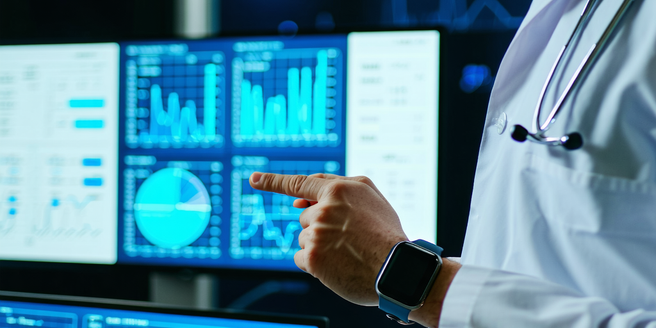Wearable Sensors In Health Monitoring

Introduction to Wearable Sensors in Healthcare
Wearable sensors are revolutionizing the healthcare landscape by providing continuous, real-time data that can be used for monitoring various health parameters. These devices range from smartwatches and fitness trackers to more specialized equipment designed to track specific conditions. They function by collecting physiological and biochemical data from the human body, aiding in health diagnostics, exercise tracking, and management of chronic diseases. Their primary advantage lies in their ability to provide ongoing health data outside traditional clinical settings, making healthcare more proactive and personalized. In essence, wearable sensors enable patients and healthcare providers to monitor heart rate, sleep patterns, and physical activity, among other indicators. This integration of technology into daily life is enhancing patient engagement, promoting preventative health measures, and ultimately shifting the paradigm of healthcare delivery.
Types of Wearable Sensors and Their Functions
Wearable sensors come in various forms, each designed to perform specific functions for different health monitoring needs. Common types include accelerometers, gyroscopes, and heart rate monitors. Accelerometers are used to measure movement and physical activity levels, beneficial for tracking exercise and daily activity. Gyroscopes complement accelerometers by providing more detailed data on orientation and balance. Heart rate monitors, often found in smartwatches, provide insights into cardiovascular health by tracking heart rate variability. Additionally, electrodermal activity sensors measure the skin’s conductance, useful for stress monitoring. Blood oxygen level sensors and temperature sensors are also key components in some advanced wearables. Each sensor type contributes to a comprehensive understanding of an individual’s health, thereby allowing for more informed healthcare decisions. These devices have applications in fitness, chronic disease management, and elderly care, among other areas.
Benefits of Wearable Sensors for Health Monitoring
Wearable sensors offer a myriad of benefits for health monitoring, enhancing both personal health management and clinical outcomes. One of their primary advantages is the ability to provide continuous, real-time data that enables proactive health management and early detection of potential issues. By monitoring key metrics such as heart rate, physical activity, and sleep patterns, individuals can gain valuable insights into their lifestyle and make informed decisions to improve their health. For healthcare providers, the data collected from wearables can be used to monitor patient compliance, track the effectiveness of treatments, and customize care plans. Moreover, wearables facilitate remote monitoring, reducing the need for frequent in-person visits and allowing patients to receive care from the comfort of their homes. This democratization of health data empowers users to take charge of their health and promotes a more personalized approach to healthcare.
Challenges in Implementing Wearable Technology
Despite their advantages, implementing wearable technology in healthcare faces several challenges. One major issue is data privacy. As these devices collect sensitive health information, ensuring secure data transmission and storage is crucial to avoid breaches. Another challenge is ensuring data accuracy and reliability. Inaccurate readings could lead to misdiagnosis or inappropriate health interventions. Additionally, the integration of wearable data into existing healthcare systems is complex, requiring standardization and interoperability between devices and electronic health records. Cost is another barrier, as high-quality sensors and devices may not be affordable for all, limiting accessibility. There’s also a need for continuous patient engagement to prevent devices from being abandoned after novelty wears off. Overcoming these challenges demands collaboration between tech companies, healthcare providers, policymakers, and patients to develop user-friendly, secure, and cost-effective wearable solutions.
Future Trends in Wearable Health Technologies
The future of wearable health technologies is promising, with several emerging trends poised to transform healthcare delivery. One significant trend is the integration of artificial intelligence and machine learning into wearable devices. This will enhance data analysis, providing deeper insights and predictive capabilities for early diagnosis and personalized care. Another trend is the miniaturization of sensors, making devices less intrusive and more comfortable for continuous wear. Hybrid wearable devices that can measure multiple parameters simultaneously are also on the rise, offering more comprehensive health monitoring. Additionally, wearables are expected to become more integrated into telemedicine, supporting remote consultations and real-time monitoring of patients’ conditions. Advances in battery technology may also extend device life, enhancing usability. These trends, coupled with growing consumer health awareness, suggest that wearables will play a crucial role in the future of healthcare.
Conclusion: The Impact of Wearables on Healthcare
Wearable technologies have had a profound impact on healthcare, ushering in a new era of personalized medicine and proactive health management. By enabling constant health monitoring, these devices provide valuable data that can improve patient care and outcomes. They empower individuals to take a more active role in their health, encouraging lifestyle changes and increasing engagement with healthcare providers. For clinicians, wearable technology offers a reliable means of accessing patient data in real-time, facilitating more informed diagnostic and treatment decisions. Moreover, wearables support the shift towards preventative care by identifying health risks early and allowing timely interventions. As technology advances, the integration of wearables into mainstream healthcare is likely to increase, heralding a shift towards more decentralized, data-driven, and patient-centered healthcare systems. The continued evolution of wearable technology holds significant potential to enhance health outcomes and transform the way healthcare is delivered.